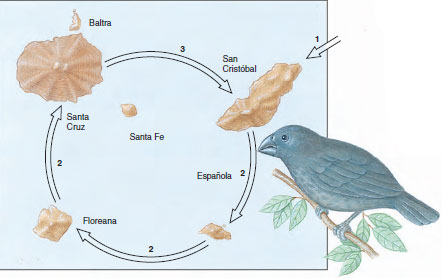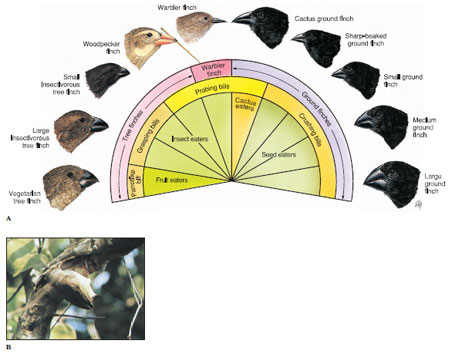Adaptive Radiation
The production of ecologically diverse species from a common ancestral stock is called adaptive radiation. Some of our best examples of adaptive radiation are associated with lakes and young islands, which are sources of new evolutionary opportunities for aquatic and terrestrial organisms, respectively. Oceanic islands formed by volcanoes are initially devoid of life. They are gradually colonized by plants and animals from a continent or from other islands in separate founder events. The founders encounter ideal situations for evolutionary diversification, because environmental resources that were heavily exploited by other species on the mainland are free for colonization on the sparsely populated island. Archipelagoes, such as the Galápagos Islands, greatly increase opportunities for both founder events and ecological diversification. The entire archipelago is isolated from the continent and each island is geographically isolated from the others by the sea; moreover, each island is different from every other one in its physical, climatic, and biotic characteristics.


alápagos finches clearly illustrate adaptive radiation on an oceanic archipelago (Figures 6-21 and 6-22). Galápagos finches (the name “Darwin’s finches” was popularized in the 1940s by the British ornithologist David Lack) are closely related to each other, but each species differs from the others in size and shape of the beak and in feeding habits. If the finches were specially created, it would require the strangest kind of coincidence for 13 similar kinds of finches to be created on the Galápagos Islands and nowhere else. Darwin’s finches descended from a single ancestral population that arrived from the mainland and subsequently colonized the different islands of the Galápagos archipelago. The finches underwent adaptive radiation, occupying habitats that on the mainland would have been denied to them by the presence of other species that are better able to exploit those habitats. Galápagos finches thus assumed the characteristics of mainland families as diverse and unfinchlike as warblers and woodpeckers. A fourteenth Darwin’s finch, found on isolated Cocos Island far north of the Galápagos archipelago, is similar in appearance to the Galápagos finches and almost certainly descended from the same ancestral stock.

Figure 6-21 Tentative model for evolution of the 13 Darwin's finches on the Galápagos Islands. The model postulates three steps: (1) Immigrant finches from the South American mainland reach the Galápagos and colonize an island; (2) once the population becomes established, finches disperse to other islands where they adapt to new conditions and change genetically; and (3) after a period of isolation, secondary contact is established between different populations. The two populations are then recognized as separate species if they cannot interbreed successfully.

Figure 6-22 A) Adaptive radiation in ten species of Darwin's finches from Santa Cruz, one of the Galápagos Islands. Differences in bills and feeding habits are shown. All apparently descended from a single common ancestral finch from the South American continent. B) Woodpecker finch, one of the 13 species of Galápagos Islands finches, using a slender twig as a tool for feeding. This finch worked for about 15 minutes before spearing and removing a wood roach from a break in the tree.
alápagos finches clearly illustrate adaptive radiation on an oceanic archipelago (Figures 6-21 and 6-22). Galápagos finches (the name “Darwin’s finches” was popularized in the 1940s by the British ornithologist David Lack) are closely related to each other, but each species differs from the others in size and shape of the beak and in feeding habits. If the finches were specially created, it would require the strangest kind of coincidence for 13 similar kinds of finches to be created on the Galápagos Islands and nowhere else. Darwin’s finches descended from a single ancestral population that arrived from the mainland and subsequently colonized the different islands of the Galápagos archipelago. The finches underwent adaptive radiation, occupying habitats that on the mainland would have been denied to them by the presence of other species that are better able to exploit those habitats. Galápagos finches thus assumed the characteristics of mainland families as diverse and unfinchlike as warblers and woodpeckers. A fourteenth Darwin’s finch, found on isolated Cocos Island far north of the Galápagos archipelago, is similar in appearance to the Galápagos finches and almost certainly descended from the same ancestral stock.




